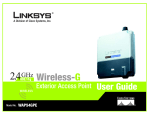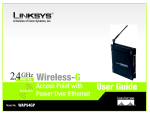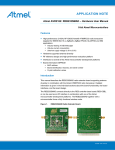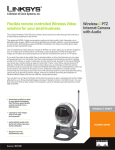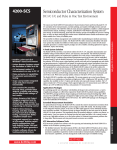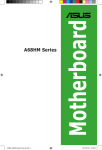Download Cisco HGA9N - Small Business HighGain Omni-Directional Antenna User guide
Transcript
USER GUIDE High Gain (9dBi) Antenna for N Type Connectors BUSINESS SERIES 2.4 GHz 802.11g Model No. HGA9N Wireless ModelModel No. No. High Gain 9dBi Omni-Directional Antenna Table of Contents Chapter 1: Introduction Chapter 2: Planning Your Wireless Antenna Coverage Chapter 3: Getting to Know the High Gain Omni-Directional Antenna Chapter 4: Connecting the High Gain Omni-Directional Antenna Appendix A: Glossary Appendix B: Specifications Appendix C: Warranty Information Appendix D: Regulatory Information Appendix E: Contact Information 1 3 7 8 11 17 18 19 21 High Gain 9dBi Omni-Directional Antenna Copyright and Trademarks Specifications are subject to change without notice. Linksys is a registered trademark or trademark of Cisco Systems, Inc. and/or its affiliates in the U.S. and certain other countries. Copyright © 2006 Cisco Systems, Inc. All rights reserved. Other brands and product names are trademarks or registered trademarks of their respective holders. WARNING: This product contains chemicals, including lead, known to the State of California to cause cancer, and birth defects or other reproductive harm. Wash hands after handling. How to Use this User Guide The user guide to the Antenna has been designed to make understanding the usage of the Antenna easier than ever. Look for the following items when reading this User Guide: This checkmark means there is a note of interest and is something you should pay special attention to while using the Antenna. This exclamation point means there is a caution or warning and is something that could damage your property or the Antenna. This question mark provides you with a reminder about something you might need to do while using the Antenna. In addition to these symbols, there are definitions for technical terms that are presented like this: word: definition. Also, each figure (diagram, screenshot, or other image) is provided with a figure number and description, like this: Figure 0-1: Sample Figure Description Figure numbers and descriptions can also be found in the “List of Figures” section. HGA9N-UG-60821 SW High Gain 9dBi Omni-Directional Antenna Chapter 1: Introduction Welcome Thank you for choosing the High Gain Omni-Directional Antenna for N Type Connectors. This guide will help you set up and place the Antenna and the access point properly so you can achieve optimal range. The Antenna and the Wireless-G Exterior Access Point together provide 9dBi peak gain and should be used together. Use the instructions in this Guide to further help you connect the 9dBi Omni-Directional Antenna to the Wireless-G Exterior Access Point and bridge your different networks. These instructions should be all you need to get the most out of the High Gain Omni-Directional Antenna. Chapter 1: Introduction Welcome 1 High Gain 9dBi Omni-Directional Antenna What’s in this User Guide? This user guide covers the steps for setting up and using the High Gain Antenna for N Type Connectors. • Chapter 1: Introduction This chapter describes the 9dBi Omni-Directional Antenna’s applications and this User Guide. • Chapter 2: Planning your Wireless Antenna Coverage This chapter describes the application of the Antenna and planning its coverage and placement. • Chapter 3: Getting to Know the High Gain 9dBi Omni-Directional Antenna This chapter describes the basics and physical characteristics of the Omni-Directional Antenna. • Chapter 4: Connecting the Wireless-G Exterior Access Point This chapter instructs you on how to connect the Omni-Directional Antenna and access point to your network. • Appendix A: Glossary This appendix gives a brief glossary of terms frequently used in networking. • Appendix B: Specifications This appendix provides the Antenna’s technical specifications. • Appendix C: Warranty Information This appendix supplies the Antenna’s warranty information. • Appendix D: Regulatory Information This appendix supplies the Antenna’s regulatory information. • Appendix E: Contact Information This appendix provides contact information for a variety of Linksys resources, including Technical Support. Chapter 1: Introduction What’s in this User Guide? 2 High Gain 9dBi Omni-Directional Antenna Chapter 2: Planning Your Wireless Antenna Coverage The Antenna Pattern for Radio Waves Figure 2-1: Antenna Pattern (Horizontal Plane) Figure 2-2: Antenna Pattern (Vertical Plane) The above two diagrams show the antenna pattern of the 9dBi Omni-Directional Antenna on the horizontal and vertical planes. The power of the wireless signal is most strong on the horizontal plane of the Antenna. The peak gain of this antenna is 9dBi. For all the applications, adjust the antenna so that it points to the peer devices on the horizontal plane. Chapter 2: Planning Your Wireless Antenna Coverage 3 High Gain 9dBi Omni-Directional Antenna Optimizing Range The power of the wireless signal is strongest on the horizontal plane of the Antenna. In the figure, note the strongest ranges according to the positioning of the Antenna. For best results, Linksys recommends placing the Antenna as illustrated. Placing the Antenna Since the Antenna is omni-directional, you have more flexibility with where you can place the access point. Keep in mind, however, that the Antenna achieves its peak gain when your client PC (that is, a PC with a wireless adapter) stays on the same horizontal plane as the Antenna. Line of sight. The minimum requirement is line of sight. If you can see the receiver antenna, then this maintains a suitable range. Avoid obstacles. Avoid obstacles and set up the Antenna and the other antennas as high as possible. Try to avoid trees, buildings, and other objects close to the path between two antennas, because they can reduce signal power. Using the Antenna The Antenna can be used with the access point for several purposes: Access point to client devices. You can achieve better range and transmission with the Antenna when connecting the wireless client (a PC with any wireless adapter) to the access point. Repeater mode. The Antenna and access point can repeat wireless signals from one access point to other devices, such as to a client PC or to other repeaters. Point-to-multipoint Bridging. The Omni-Directional Antenna connects to one main access point. The main access point connects to other access points that each use a separate Directional Antenna. To achieve maximum distance coverage, the other access points are usually located in different directions from the main access point. Chapter 2: Planning Your Wireless Antenna Coverage NOTE: The Antenna does not provide extra value for point-to-point bridging. You can achieve the same antenna gain by using the internal directional antenna from the access point. 4 High Gain 9dBi Omni-Directional Antenna How to Achieve Optimal Gain Wireless coverage depends on several factors, including power and transmission. You can calculate exact coverage distance by gathering the specifications of the access point and the Antenna and using the equation below. Using this equation is not needed in order to place the Antenna and the access point, but it may be beneficial in optimizing use of your Antenna and access point. λ S r = S t + G t + G r + 20 ⋅ log ---------- – 20 ⋅ log ( d ) – LinkBudget 4⋅π In this formula, everything is in dBm or dB. Sr is the received power. Here we plug in the receiver sensitivity to calculate the maximum distance. For example, -82dBm for 11Mbps. St is the transmitted power. For example, 18dBm for 11Mbps. Gt is the transmitter antenna gain and Gr is the receiver antenna gain (9dBi for this Antenna). λ is the wavelength of the signal. The product of λ and frequency equals to speed of light (c). d is the distance. LinkBudget is the lumpsum of additional loss (compared to free space) in the path. Chapter 2: Planning Your Wireless Antenna Coverage 5 High Gain 9dBi Omni-Directional Antenna Distance Calculations You can use the tables below to determine how you want to place the Antenna in relation to the access point to client device or between the two access points. As you can see, the higher the transmit data rate, the shorter the coverage distance. Therefore, when a client device moves further away from an access point, the data rate will fall back to a lower data rate. Table 1: Coverage Distance from Access Point to Client Devices* Data Rate 11 Mbps 54 Mbps Distance 0.88 km 0.12 km Distance 0.55 mile 0.078 mile Table 2: Coverage Distance from Access Point to Access Point* Data Rate 11 Mbps 54 Mbps Distance 2.49 km 0.35 km Distance 1.56 mile 0.22 mile *To obtain these calculations, we inserted the specifications of the access point into the formula above. We use 9dBi peak antenna gain and assume 0dBi antenna gain at the client device. Link budget is set to 10dB to include radio wave attenuations from different types of objects in the path (the actual value may vary). Chapter 2: Planning Your Wireless Antenna Coverage 6 High Gain 9dBi Omni-Directional Antenna Chapter 3: Getting to Know the High Gain Omni-Directional Antenna This chapter explains the components that come with the 9dBi Omni-Directional Antenna. The Antenna Port The Antenna has only one port in the tip closer to the mounting bracket. For installation purposes, it is important to note that the antenna port has a female N-type connector and should only be connected to the male cable connector. Figure 3-1: Antenna Port Antenna Cable One six-foot low-loss antenna cable is included with this product and is used to connect the Antenna to the access point. Note that the two connectors have different polarities and one connector is marked with white tape. The connector with white tape connects to the access point. The Lightning Protector (Surge Arrestor) The Lightning protector is used to protect your 9dBi Omni-Directional Antenna when it is used in an outdoor environment. The lightning protector screws into the end of the Antenna. Although it is not required, Linksys recommends using the lightening protector to help prevent damage to equipment. Figure 3-2: Antenna Cable Mounting Kit A kit including U-clamps, nuts, washers, and screws are provided to mount the Antenna. Figure 3-3: Lightning Protector Chapter 3: Getting to Know the High Gain Omni-Directional Antenna 7 High Gain 9dBi Omni-Directional Antenna Chapter 4: Connecting the High Gain Omni-Directional Antenna Overview This chapter explains how to mount and connect the Antenna to the Wireless-G Exterior Access Point. Connection 1. Make sure you have all of the hardware displayed below, including a plastic bag containing the mounting hardware. 9dBi Omni-Directional Antenna Lightening Protector Cable Exterior Access Point Figure 4-1: Typical External Antenna Setup Chapter 4: Connecting the High Gain Omni-Directional Antenna 8 High Gain 9dBi Omni-Directional Antenna 2. Obtain a location for the 9dBi Omni-Directional Antenna. The location should have a clear view to the peer Antenna. Refer to the Antenna Pattern in Chapter 2: Planning Your Wireless Antenna Coverage for detailed information on how to adjust the 9dBi Omni-Directional Antenna for your application. 3. Determine whether you will mount the Antenna to a pole or a wall. Follow the mounting instructions as displayed. Wall Mounting Pole Mounting 1 Antenna ................ 1 pc 1 Antenna ............... 1 pc 2 Sticker .................. 2 pc 2 Hose clamp ......... 2 pcs 3 Plastic Fixings ...... 4 pcs 3 Holder ................. 1 pc 4 Holder ................... 1 pc 4 Washers ............. 4 pcs 5 Washers ................ 4 pcs 5 Screw nuts ........ 4 pcs 6 Screws ................. 4 pcs Chapter 4: Connecting the High Gain Omni-Directional Antenna 9 High Gain 9dBi Omni-Directional Antenna 4. The bottom of the Antenna has a removable black covering. Remove this and attach the lightening protector as illustrated below by inserting the male end of the protector into the Antenna. Connect the Lightening Protector to the Antenna 5. Attach the male cable end of the cable to the lightning protector. Connect the Cable to the Lightening Protector 6. Attach the male end of the cable that has the white tape around it to the Wireless-G Exterior Access Point. 7. If you are mounting to a pole, insert the pole (not included) into the mounting bracket assembly. As discussed previously, the pole must give the antenna at least 2 meters of clearance from the ground. 8. If you are mounting to a base (not included), make sure the base is secure. Congratulations! The connection is complete. You can begin using the Antenna. Connect the Access Point to the Cable Chapter 4: Connecting the High Gain Omni-Directional Antenna 10 High Gain 9dBi Omni-Directional Antenna Appendix A: Glossary 802.11a - A wireless networking standard that specifies a maximum data transfer rate of 54Mbps and an operating frequency of 5GHz. 802.11b - A wireless networking standard that specifies a maximum data transfer rate of 11Mbps and an operating frequency of 2.4GHz. 802.11g - A wireless networking standard that specifies a maximum data transfer rate of 54Mbps, an operating frequency of 2.4GHz, and backward compatibility with 802.11b devices. Access Point - A device that allows wireless-equipped computers and other devices to communicate with a wired network. Also used to expand the range of a wireless network. Adapter - A device that adds network functionality to your PC. Ad-hoc - A group of wireless devices communicating directly with each other (peer-to-peer) without the use of an access point. AES (Advanced Encryption Standard) - A security method that uses symmetric 128-bit block data encryption. Backbone - The part of a network that connects most of the systems and networks together, and handles the most data. Bandwidth - The transmission capacity of a given device or network. Beacon Interval - Data transmitted on your wireless network that keeps the network synchronized. Bit - A binary digit. Boot - To start a device and cause it to start executing instructions. Bridge - A device that connects different networks. Broadband - An always-on, fast Internet connection. Browser - An application program that provides a way to look at and interact with all the information on the World Wide Web. Buffer - A shared or assigned memory area that is used to support and coordinate different computing and networking activities so one isn't held up by the other. Byte - A unit of data that is usually eight bits long Cable Modem - A device that connects a computer to the cable television network, which in turn connects to the Internet. CSMA/CA (Carrier Sense Multiple Access/Collision Avoidance) - A method of data transfer that is used to prevent data collisions. Appendix B: Glossary 11 High Gain 9dBi Omni-Directional Antenna CTS (Clear To Send) - A signal sent by a wireless device, signifying that it is ready to receive data. Database - A collection of data that is organized so that its contents can easily be accessed, managed, and updated. DDNS (Dynamic Domain Name System) - Allows the hosting of a website, FTP server, or e-mail server with a fixed domain name (e.g., www.xyz.com) and a dynamic IP address. Default Gateway - A device that forwards Internet traffic from your local area network. DHCP (Dynamic Host Configuration Protocol) - A networking protocol that allows administrators to assign temporary IP addresses to network computers by “leasing” an IP address to a user for a limited amount of time, instead of assigning permanent IP addresses. DMZ (Demilitarized Zone) - Removes the Router's firewall protection from one PC, allowing it to be “seen” from the Internet. DNS (Domain Name Server) - The IP address of your ISP's server, which translates the names of websites into IP addresses. Domain - A specific name for a network of computers. Download - To receive a file transmitted over a network. DSL (Digital Subscriber Line) - An always-on broadband connection over traditional phone lines. DSSS (Direct-Sequence Spread-Spectrum) - Frequency transmission with a redundant bit pattern resulting in a lower probability of information being lost in transit. DTIM (Delivery Traffic Indication Message) - A message included in data packets that can increase wireless efficiency. Dynamic IP Address - A temporary IP address assigned by a DHCP server. EAP (Extensible Authentication Protocol) - A general authentication protocol used to control network access. Many specific authentication methods work within this framework. EAP-PEAP (Extensible Authentication Protocol-Protected Extensible Authentication Protocol) - A mutual authentication method that uses a combination of digital certificates and another system, such as passwords. EAP-TLS (Extensible Authentication Protocol-Transport Layer Security) - A mutual authentication method that uses digital certificates. Encryption - Encoding data transmitted in a network. Ethernet - A networking protocol that specifies how data is placed on and retrieved from a common transmission medium. Finger - A program that tells you the name associated with an e-mail address. Appendix B: Glossary 12 High Gain 9dBi Omni-Directional Antenna Firewall - A set of related programs located at a network gateway server that protects the resources of a network from users from other networks. Firmware - The programming code that runs a networking device. Fragmentation -Breaking a packet into smaller units when transmitting over a network medium that cannot support the original size of the packet. FTP (File Transfer Protocol) - A protocol used to transfer files over a TCP/IP network. Full Duplex - The ability of a networking device to receive and transmit data simultaneously. Gateway - A device that interconnects networks with different, incompatible communications protocols. Half Duplex - Data transmission that can occur in two directions over a single line, but only one direction at a time. Hardware - The physical aspect of computers, telecommunications, and other information technology devices. HTTP (HyperText Transport Protocol) - The communications protocol used to connect to servers on the World Wide Web. Infrastructure - A wireless network that is bridged to a wired network via an access point. IP (Internet Protocol) - A protocol used to send data over a network. IP Address - The address used to identify a computer or device on a network. Important: Always remember that each device in your wireless network MUST use the same encryption method and encryption key or your wireless network will not function properly. IPCONFIG - A Windows 2000 and XP utility that displays the IP address for a particular networking device. IPSec (Internet Protocol Security) - A VPN protocol used to implement secure exchange of packets at the IP layer. ISM band - Radio bandwidth utilized in wireless transmissions. ISP (Internet Service Provider) - A company that provides access to the Internet. LAN - The computers and networking products that make up your local network. LEAP (Lightweight Extensible Authentication Protocol) - A mutual authentication method that uses a username and password system. MAC (Media Access Control) Address - The unique address that a manufacturer assigns to each networking device. Mbps (MegaBits Per Second) - One million bits per second; a unit of measurement for data transmission. mIRC - An Internet Relay Chat program that runs under Windows. Multicasting - Sending data to a group of destinations at once. Appendix B: Glossary 13 High Gain 9dBi Omni-Directional Antenna NAT (Network Address Translation) - NAT technology translates IP addresses of a local area network to a different IP address for the Internet. Network - A series of computers or devices connected for the purpose of data sharing, storage, and/or transmission between users. NNTP (Network News Transfer Protocol) - The protocol used to connect to Usenet groups on the Internet. Node - A network junction or connection point, typically a computer or work station. OFDM (Orthogonal Frequency Division Multiplexing) - Frequency transmission that separates the data stream into a number of lower-speed data streams, which are then transmitted in parallel to prevent information from being lost in transit. Packet - A unit of data sent over a network. Passphrase - Used much like a password, a passphrase simplifies the WEP encryption process by automatically generating the WEP encryption keys for Linksys products. PEAP (Protected Extensible Authentication Protocol) - A mutual authentication method that uses a combination of digital certificates and another system, such as passwords. Ping (Packet INternet Groper) - An Internet utility used to determine whether a particular IP address is online. POP3 (Post Office Protocol 3) - A standard mail server commonly used on the Internet. Port - The connection point on a computer or networking device used for plugging in cables or adapters. PPPoE (Point to Point Protocol over Ethernet) - A type of broadband connection that provides authentication (username and password) in addition to data transport. PPTP (Point-to-Point Tunneling Protocol) - A VPN protocol that allows the Point to Point Protocol (PPP) to be tunneled through an IP network. This protocol is also used as a type of broadband connection in Europe. Preamble - Part of the wireless signal that synchronizes network traffic. RADIUS (Remote Authentication Dial-In User Service) - A protocol that uses an authentication server to control network access. RJ-45 (Registered Jack-45) - An Ethernet connector that holds up to eight wires. Roaming - The ability to take a wireless device from one access point's range to another without losing the connection. Router - A networking device that connects multiple networks together. RTS (Request To Send) - A networking method of coordinating large packets through the RTS Threshold setting. Appendix B: Glossary 14 High Gain 9dBi Omni-Directional Antenna Server - Any computer whose function in a network is to provide user access to files, printing, communications, and other services. SMTP (Simple Mail Transfer Protocol) - The standard e-mail protocol on the Internet. SNMP (Simple Network Management Protocol) - A widely used network monitoring and control protocol. Software - Instructions for the computer. A series of instructions that performs a particular task is called a “program”. SOHO (Small Office/Home Office) - Market segment of professionals who work at home or in small offices. SPI (Stateful Packet Inspection) Firewall - A technology that inspects incoming packets of information before allowing them to enter the network. Spread Spectrum - Wideband radio frequency technique used for more reliable and secure data transmission. SSID (Service Set IDentifier) - Your wireless network's name. Static IP Address - A fixed address assigned to a computer or device that is connected to a network. Static Routing - Forwarding data in a network via a fixed path. Subnet Mask - An address code that determines the size of the network. Switch - 1. A data switch that connects computing devices to host computers, allowing a large number of devices to share a limited number of ports. 2. A device for making, breaking, or changing the connections in an electrical circuit. TCP (Transmission Control Protocol) - A network protocol for transmitting data that requires acknowledgement from the recipient of data sent. TCP/IP (Transmission Control Protocol/Internet Protocol) - A set of instructions PCs use to communicate over a network. Telnet - A user command and TCP/IP protocol used for accessing remote PCs. TFTP (Trivial File Transfer Protocol) - A version of the TCP/IP FTP protocol that has no directory or password capability. Throughput - The amount of data moved successfully from one node to another in a given time period. TKIP (Temporal Key Integrity Protocol) - a wireless encryption protocol that provides dynamic encryption keys for each packet transmitted. Topology - The physical layout of a network. TX Rate - Transmission Rate. UDP (User Datagram Protocol) - A network protocol for transmitting data that does not require acknowledgement from the recipient of the data that is sent. Appendix B: Glossary 15 High Gain 9dBi Omni-Directional Antenna Upgrade - To replace existing software or firmware with a newer version. Upload - To transmit a file over a network. URL (Uniform Resource Locator) - The address of a file located on the Internet. VPN (Virtual Private Network) - A security measure to protect data as it leaves one network and goes to another over the Internet. WAN (Wide Area Network)- The Internet. WEP (Wired Equivalent Privacy) - A method of encrypting network data transmitted on a wireless network for greater security. WINIPCFG - A Windows 98 and Me utility that displays the IP address for a particular networking device. WLAN (Wireless Local Area Network) - A group of computers and associated devices that communicate with each other wirelessly. WPA (Wi-Fi Protected Access) - a wireless security protocol using TKIP (Temporal Key Integrity Protocol) encryption, which can be used in conjunction with a RADIUS server. Appendix B: Glossary 16 High Gain 9dBi Omni-Directional Antenna Appendix B: Specifications Model HGA9N Ports 1 N-type female connector Cabling Type Coax - 50 Ohm impedance Frequency Range 2400 MHz - 2500 MHz Peak Gain 9 dBi VSWR 1.92 : 1 Max Polarization Linear, vertical HPBW / horizontal 360º HPBW / vertical 11º Impedance 50 Ohms Range Maximum Outdoor range* - 0.88 km (0.55 mi) @ 11 Mbps, 0.12 km (0.078 mi) @ 54Mbps Dimensions 2.95” x 24.6” x 2.20” (75 x 625 x 56mm) Mounting Options Mounting kit provided Operating Temp. -22 to 176ºF (-30ºC to 80ºC) Storage Temp. -22 to 176ºF (-30ºC to 80ºC) Operating Humidity 5% to 95%, non-condensing Storage Humidity 5% to 95%, non-condensing * Range estimation is based on one WAP54GPE Access point with HGA9N antenna attached to wireless client with 0dBi antenna under ideal line-of-sight conditions Appendix B: Specifications 17 High Gain 9dBi Omni-Directional Antenna Appendix C: Warranty Information LIMITED WARRANTY Linksys warrants to You that, for a period of three years (the “Warranty Period”), your Linksys Product will be substantially free of defects in materials and workmanship under normal use. Your exclusive remedy and Linksys' entire liability under this warranty will be for Linksys at its option to repair or replace the Product or refund Your purchase price less any rebates. This limited warranty extends only to the original purchaser. If the Product proves defective during the Warranty Period call Linksys Technical Support in order to obtain a Return Authorization Number, if applicable. BE SURE TO HAVE YOUR PROOF OF PURCHASE ON HAND WHEN CALLING. If You are requested to return the Product, mark the Return Authorization Number clearly on the outside of the package and include a copy of your original proof of purchase. RETURN REQUESTS CANNOT BE PROCESSED WITHOUT PROOF OF PURCHASE. You are responsible for shipping defective Products to Linksys. Linksys pays for UPS Ground shipping from Linksys back to You only. Customers located outside of the United States of America and Canada are responsible for all shipping and handling charges. ALL IMPLIED WARRANTIES AND CONDITIONS OF MERCHANTABILITY OR FITNESS FOR A PARTICULAR PURPOSE ARE LIMITED TO THE DURATION OF THE WARRANTY PERIOD. ALL OTHER EXPRESS OR IMPLIED CONDITIONS, REPRESENTATIONS AND WARRANTIES, INCLUDING ANY IMPLIED WARRANTY OF NON-INFRINGEMENT, ARE DISCLAIMED. Some jurisdictions do not allow limitations on how long an implied warranty lasts, so the above limitation may not apply to You. This warranty gives You specific legal rights, and You may also have other rights which vary by jurisdiction. This warranty does not apply if the Product (a) has been altered, except by Linksys, (b) has not been installed, operated, repaired, or maintained in accordance with instructions supplied by Linksys, or (c) has been subjected to abnormal physical or electrical stress, misuse, negligence, or accident. In addition, due to the continual development of new techniques for intruding upon and attacking networks, Linksys does not warrant that the Product will be free of vulnerability to intrusion or attack. TO THE EXTENT NOT PROHIBITED BY LAW, IN NO EVENT WILL LINKSYS BE LIABLE FOR ANY LOST DATA, REVENUE OR PROFIT, OR FOR SPECIAL, INDIRECT, CONSEQUENTIAL, INCIDENTAL OR PUNITIVE DAMAGES, REGARDLESS OF THE THEORY OF LIABILITY (INCLUDING NEGLIGENCE), ARISING OUT OF OR RELATED TO THE USE OF OR INABILITY TO USE THE PRODUCT (INCLUDING ANY SOFTWARE), EVEN IF LINKSYS HAS BEEN ADVISED OF THE POSSIBILITY OF SUCH DAMAGES. IN NO EVENT WILL LINKSYS’ LIABILITY EXCEED THE AMOUNT PAID BY YOU FOR THE PRODUCT. The foregoing limitations will apply even if any warranty or remedy provided under this Agreement fails of its essential purpose. Some jurisdictions do not allow the exclusion or limitation of incidental or consequential damages, so the above limitation or exclusion may not apply to You. Please direct all inquiries to: Linksys, P.O. Box 18558, Irvine, CA 92623. 18 Appendix C: Warranty Information High Gain 9dBi Omni-Directional Antenna Appendix D: Regulatory Information FCC STATEMENT This product has been tested and complies with the specifications for a Class B digital device, pursuant to Part 15 of the FCC Rules. These limits are designed to provide reasonable protection against harmful interference in a residential installation. This equipment generates, uses, and can radiate radio frequency energy and, if not installed and used according to the instructions, may cause harmful interference to radio communications. However, there is no guarantee that interference will not occur in a particular installation. If this equipment does cause harmful interference to radio or television reception, which is found by turning the equipment off and on, the user is encouraged to try to correct the interference by one or more of the following measures: Reorient or relocate the receiving antenna Increase the separation between the equipment or devices Connect the equipment to an outlet other than the receiver's Consult a dealer or an experienced radio/TV technician for assistance FCC Radiation Exposure Statement This equipment complies with FCC radiation exposure limits set forth for an uncontrolled environment. This equipment should be installed and operated with minimum distance 20cm between the radiator and your body. INDUSTRY CANADA (CANADA) This Class B digital apparatus complies with Canadian ICES-003, RSS210. Cet appareil numérique de la classe B est conforme à la norme NMB-003 du Canada. The use of this device in a system operating either partially or completely outdoors may require the user to obtain a license for the system according to the Canadian regulations. EC DECLARATION OF CONFORMITY (EUROPE) Linksys declares that this product conforms to the specifications listed below, following the provisions of the European R&TTE directive 1999/5/EC: EN 301 489-1, 301 489-17 General EMC requirements for Radio equipment. EN 609 50 Safety Appendix D: Regulatory Information 19 High Gain 9dBi Omni-Directional Antenna EN 300-328-1, EN 300-328-2 Technical requirements for Radio equipment. Caution: This equipment is intended to be used in all EU and EFTA countries. Outdoor use may be restricted to certain frequencies and/or may require a license for operation. Contact local Authority for procedure to follow. Note: Combinations of power levels and antennas resulting in a radiated power level of above 100 mW equivalent isotropic radiated power (EIRP) are considered as not compliant with the above mentioned directive and are not allowed for use within the European community and countries that have adopted the European R&TTE directive 1999/5/EC. For more details on legal combinations of power levels and antennas, contact Linksys Corporate Compliance. Linksys vakuuttaa täten että dieses produkt tyyppinen laite on direktiivin 1999/5/EY oleellisten vaatimusten ja sitä koskevien näiden direktiivien muiden ehtojen mukainen. Linksys déclare que le produit est conforme aux conditions essentielles et aux dispositions relatives à la directive 1999/5/EC. Belgique: Dans le cas d'une utilisation privée, à l'extérieur d'un bâtiment, au-dessus d'un espace public, aucun enregistrement n'est nécessaire pour une distance de moins de 300m. Pour une distance supérieure à 300m un enregistrement auprès de l'IBPT est requise. Pour une utilisation publique à l'extérieur de bâtiments, une licence de l'IBPT est requise. Pour les enregistrements et licences, veuillez contacter l'IBPT. France: 2.4 GHz Bande : les canaux 10, 11, 12, 13 (2457, 2462, 2467, et 2472 MHz respectivement) sont complétement libres d'utilisation en France (en utilisation intérieur). Pour ce qui est des autres canaux, ils peuvent être soumis à autorisation selon le départment. L'utilisation en extérieur est soumis à autorisation préalable et très restreint. Vous pouvez contacter l'Autorité de Régulation des Télécommunications (http://www.art-telecom.fr) pour de plus amples renseignements. SAFETY NOTICES Caution: To reduce the risk of fire, use only No.26 AWG or larger telecommunication line cord. Do not use this product near water, for example, in a wet basement or near a swimming pool. Avoid using this product during an electrical storm. There may be a remote risk of electric shock from lightning. Appendix D: Regulatory Information 20 High Gain 9dBi Omni-Directional Antenna Appendix E: Contact Information Need to contact Linksys? Visit us online for information on the latest products and updates to your existing products at: http://www.linksys.com or ftp.linksys.com Can't find information about a product you want to buy on the web? Do you want to know more about networking with Linksys products? Give our advice line a call at: Or fax your request in to: 800-546-5797 (LINKSYS) 949-823-3002 If you experience problems with any Linksys product, you can call us at: Don't wish to call? You can e-mail us at: 800-326-7114 [email protected] If any Linksys product proves defective during its warranty period, you can call the Linksys Return Merchandise Authorization department for obtaining a Return Authorization Number at: (Details on Warranty and RMA issues can be found in the Warranty Information section in this Guide.) 949-823-3000 21 Appendix E: Contact Information
























